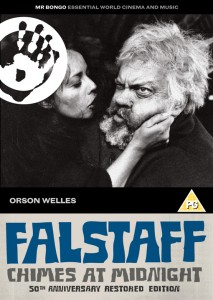Falstaff / Chimes at Midnight 2015. GB. DVD or Blu-ray. Mr Bongo. 116 minutes. £12.99 (Blu-ray), £8.99 (DVD)
 About the Reviewer: Emma Smith works at Hertford College as Fellow and Tutor in English, and at the University of Oxford as Professor of Shakespeare Studies. She is the author of Macbeth: Language and Writing (2013), co-author of Thirty Great Myths About Shakespeare (2012) and has been published in the Shakespeare Quarterly (2013) and the Shakespeare Bulletin (March 2014). Emma is currently working on the First Folio (1623), a project combining aspects of the history of the book, histories of reading, and the interpretation of Shakespeare on the page.
About the Reviewer: Emma Smith works at Hertford College as Fellow and Tutor in English, and at the University of Oxford as Professor of Shakespeare Studies. She is the author of Macbeth: Language and Writing (2013), co-author of Thirty Great Myths About Shakespeare (2012) and has been published in the Shakespeare Quarterly (2013) and the Shakespeare Bulletin (March 2014). Emma is currently working on the First Folio (1623), a project combining aspects of the history of the book, histories of reading, and the interpretation of Shakespeare on the page.
Falstaff / Chimes at Midnight (1966) is Orson Welles’ third Shakespeare film and his own favourite. Like Citizen Kane (1941) it offers the portrait of a self-interested man in a ruthlessly pragmatic world; like The Magnificent Ambersons (1942) it is haunted by a lost golden world; like Othello (1952) its artistic vision is contained by the exigencies of studio financing. Welles recasts Shakespeare’s history plays, particularly 1 and 2 Henry IV, but with some lines from Henry V and The Merry Wives of Windsor, and a few narrative snippets from the historical source, Holinshed, into a bittersweet biography.  In place of the classic ‘Henriad’: t the story of Prince Hal’s coming to maturity, he gives us the fleshy physicality of the ageing Falstaff: loveable, dishonest, egotistic. The nostalgic title derives from the elderly Justice Shallow’s doddery recollections of his rakish youth: ‘we have heard the chimes at midnight’. It’s a lament for what Welles called ‘Merrie England’: an idealised medieval world of good fellowship and feudal loyalty. Unlike Shakespeare, the film has little affection for Hotspur (Norman Rodway), a buffoon who emerges half-dressed from a bathtub. Even his death at Shrewsbury is underplayed. The ‘double reign’ (1 HIV) here is not that of Hotspur and Hal. Instead, Keith Baxter as a handsome, thoughtless Hal is caught between the film’s two patriarchs: the ascetic king and the gluttonous knight. He must betray both of them to turn English civil war outwards towards France.
In place of the classic ‘Henriad’: t the story of Prince Hal’s coming to maturity, he gives us the fleshy physicality of the ageing Falstaff: loveable, dishonest, egotistic. The nostalgic title derives from the elderly Justice Shallow’s doddery recollections of his rakish youth: ‘we have heard the chimes at midnight’. It’s a lament for what Welles called ‘Merrie England’: an idealised medieval world of good fellowship and feudal loyalty. Unlike Shakespeare, the film has little affection for Hotspur (Norman Rodway), a buffoon who emerges half-dressed from a bathtub. Even his death at Shrewsbury is underplayed. The ‘double reign’ (1 HIV) here is not that of Hotspur and Hal. Instead, Keith Baxter as a handsome, thoughtless Hal is caught between the film’s two patriarchs: the ascetic king and the gluttonous knight. He must betray both of them to turn English civil war outwards towards France.
Welles’ direction contrasts the cold perpendicular architecture of the king’s court with the half-timbered warmth of the Eastcheap tavern. John Gielgud’s Henry IV sits on a distant throne, lit by a shaft of light:. The most conventional moment in the film is his soliloquy on the sleeplessness of kingship, a cut-glass audition piece looking out of a window, face sculpturally lit. In the tavern, a more mobile camera emphasises the softer shapes of furnishings and relaxed human bodies, to accentuate Shakespeare’s own distinction between the worlds of politics and of pleasure. Throughout, close-ups direct our sympathy, as when Falstaff tries intercept the newly crowned king. Here, filmic space is an index of intimacy. As the camera tries to glimpse through the ranks of guards, it is clear that we, like Falstaff, can no longer get close to King Henry V. In becoming king, Hal has moved out of the close-up of emotional proximity and into the mid-shot of monarchical power. Welles’ other signature shot, the extreme low angle, is also present, most notably in framing the standards and spears of the warring factions against an unforgivingly blank sky, distorting the nobles into overbearing bullies.
The most famous sequence in the film is the Battle of Shrewsbury, brilliantly edited to amplify its personnel and length. Welles makes a kind of robotic poetry out of the sheer visual chaos of this long scene, in which rapid cuts, pans, and experiments with film speed establish the savagery, and the moral uncertainty, of the conflict. Watching it fifty years after its first release, its affinities to the queasy war films inspired by Vietnam are evident. Another, less lauded but sharply realised scene is that of the robbery at Gad’s Hill. A chiaroscuro forest, shot in wide-angle landscape format like an Uccello painting, provides an almost abstract vertical structure for the heist, and across these stripes, black and white costumes clarify the visual contrast.
Copyright problems have long restricted viewing of Chimes at Midnight, so the release is to be welcomed. The DVD has no extras or commentary, however, and it reproduces the problems of a muffled soundtrack that have dogged this film from its cinematic release. In certain ways the film is dated. The supernumerary scantily clad women in the tavern, for instance, have a definite 60s air (and eye make-up to match): whatever Shakespeare’s history plays might offer for women is here diminished and objectified. Despite these shortcomings, Welles’ central performance, and the film’s bold rescripting of the plays as a ‘Falstaffiad’, make compelling viewing.
Emma Smith
https://youtu.be/1qRoyUcOi4E